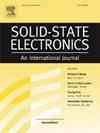Investigation on MOS shunt LVTSCR for ESD application
Abstract
Continuously scaling down ICs result in more stringent electrostatic discharge (ESD) protection design requirements. Compared with other devices, silicon-controlled rectifier (SCR) has become the first choice for its area efficiency and robustness. In order to improve the latch-up issue of SCR, various schemes have been proposed. A simple method is to extend the SCR path length, which will result in the enlarged ON resistance. Segment technology is also used to improve the holding voltage of SCR, but it will shrink the effective emitter area and lead to the serious degradation of ESD robustness. MS-LVTSCR is used to protect CMOS input ports. The circuit operating voltage is 3.3V and the gate oxide DC breakdown voltage is 19V so that considering the safety margin, the ESD window is from 3.63V to 17.1V. This work proposes a novel MOS shunt low-voltage trigger silicon-controlled rectifier (MS-LVTSCR) electrostatic discharge protection device by inserting an embedded PMOS structure. Compared with the conventional LVTSCR, the proposed MS-LVTSCR achieves 53% improvement in the holding voltage and still maintains high ESD robustness with a current level of 31.5 mA/m without more device area consumption. In addition, both the TCAD simulation and theoretical analysis were carried out to explore the principle of current shunt effect to improve holding voltage. The extra shunt paths will weaken the conductance modulation effect of the main drift region in the main SCR path and its holding voltage can be further raised by reducing the proportion of main drift region current in the total current. We also conducted detailed studies on the mechanisms and geometry effects of this newly proposed structure via experimental validations.

 求助内容:
求助内容: 应助结果提醒方式:
应助结果提醒方式:


